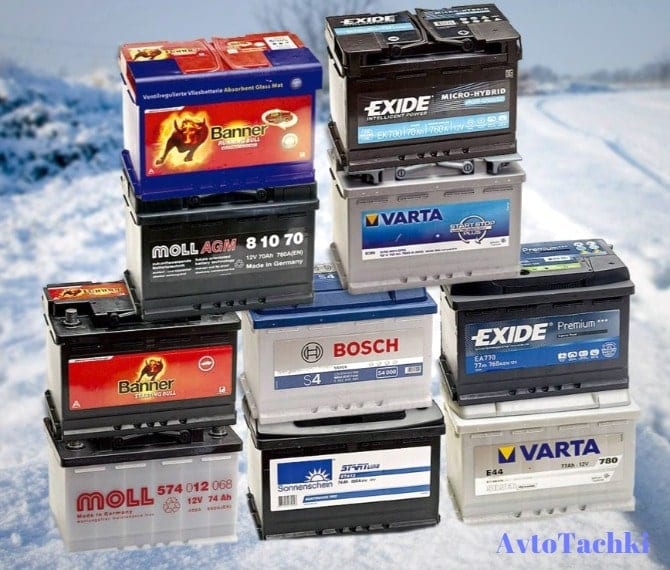
How to store a car battery
Content
- Car battery storage
- Types of batteries
- Do I need to remove the battery in winter
- Preparing the battery for winter
- How and where to store the battery in winter
- Storing a new car battery
- Is it possible to store the battery in the cold
- In what state to store the battery
- How long can a battery be stored without recharging?
- Car battery recovery after winter
- How to store the battery for a long time
- Questions and answers:
Car battery storage
The main task of the battery in the car is to start the engine. Therefore, the stability of your “iron horse” depends on its serviceability. The most dangerous period for a battery is winter, since long downtime in the cold negatively affects the correct functioning of any battery, and a car battery is no exception.
In this article, we will talk about how to prepare the battery for winter and how to properly store it so that it serves you faithfully for many years.
Types of batteries
There are three main categories of batteries:
- Serviced. Such batteries are filled with liquid electrolyte. During the operation of the car’s electrical devices, water from the cans evaporates, so it is necessary to periodically check the electrolyte level and its density. To perform such procedures in banks made inspection holes.
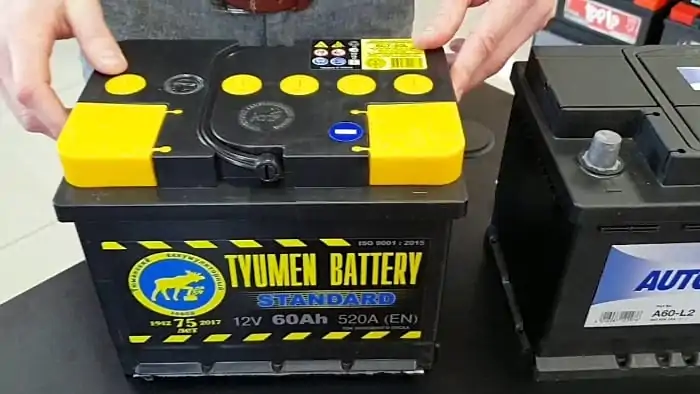
- Low maintenance. Such modifications have one filling hole and are equipped with a valve (the material for its manufacture is neoprene rubber, resistant to acid). This design allows to reduce the loss of water from the electrolyte. When the pressure rises to prevent depressurization of the body, the valve is activated.
- Unattended. In such batteries, gas generation is minimized. This effect can be achieved by directing the oxygen formed near the positive electrode to the negative one, where it will react with hydrogen, from which the evaporated water immediately returns to the liquid state. A thickener is added to the electrolyte to accelerate such a reaction. It retains oxygen bubbles in the solution, which increases the likelihood of them reaching the negative electrode. In some modifications, liquid electrolyte continues to be poured, but so that the electrodes remain moistened, a glass fiber with microscopic pores is put on them. Such battery models have greater efficiency compared to gel ones, but due to poor contact of the liquid with the rods, their resource is less.
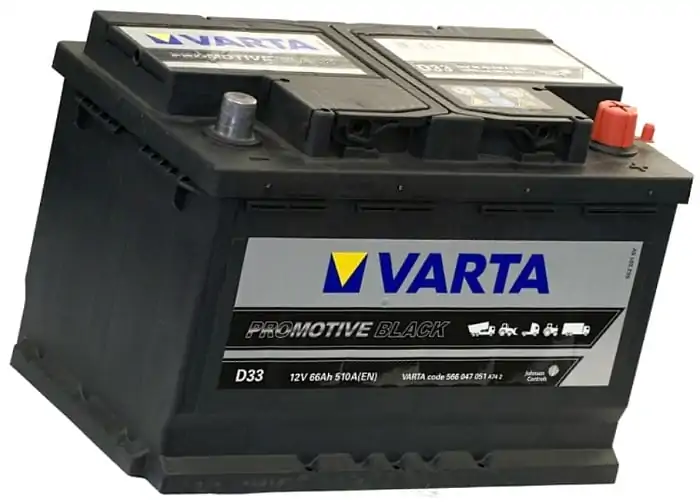
The categories of serviced and low-maintenance batteries include:
- If the composition of lead plates includes more than 5 percent of antimony, then such modifications are called antimony. This substance is added to slow down the decay of lead. The disadvantage of such batteries is the accelerated process of sulfation (more often it is necessary to add distillate), therefore, today they are rarely used.
- Low-antimony modifications in lead plates contain less than 5% antimony, which increases the efficiency of batteries (they are stored longer and hold a charge better).
- Calcium batteries instead of antimony contain calcium. Such models have increased efficiency. The water in them does not evaporate as intensively as in the antimony, but they are sensitive to deep discharge. The motorist should not be allowed to fully discharge the battery, otherwise it will quickly fail.
- Hybrid batteries contain both antimony and calcium. The positive plates include antimony, and the negative ones include calcium. This combination allows you to achieve a "middle ground" between reliability and efficiency. They are not as sensitive to discharges as calcium analogues.
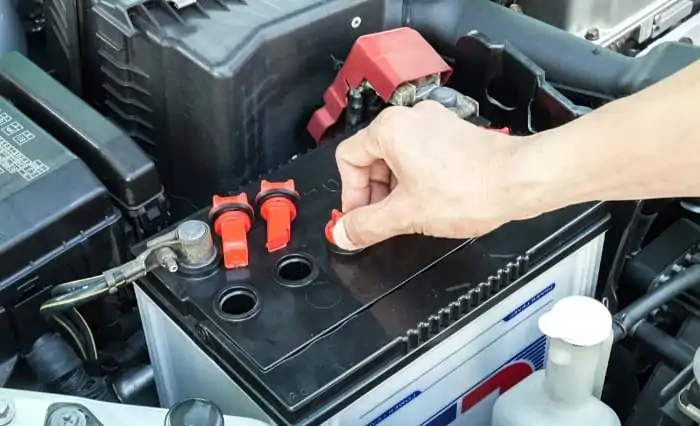
Maintenance-free batteries are resistant to self-discharge (at a temperature of +20 they lose only 2% of their charge per month). They do not emit toxic fumes. This category includes:
- Gel. Instead of liquid electrolyte, such batteries are filled with silica gel. In such modifications, drainage and scattering of the plates are excluded. They have up to 600 charge / discharge cycles, but require high precision charging, so you need to use special chargers for this.
- AGM (absorbent). These batteries use liquid electrolyte. Between the lead plates is a special twin-ball fiberglass. The finely porous part ensures constant contact of the plates with the electrolyte, and the large-porous part provides the supply of oxygen bubbles to the opposite plates for reaction with hydrogen. They do not need accurate charging, but with increasing voltage, the housing can swell. Resource - up to 300 cycles.
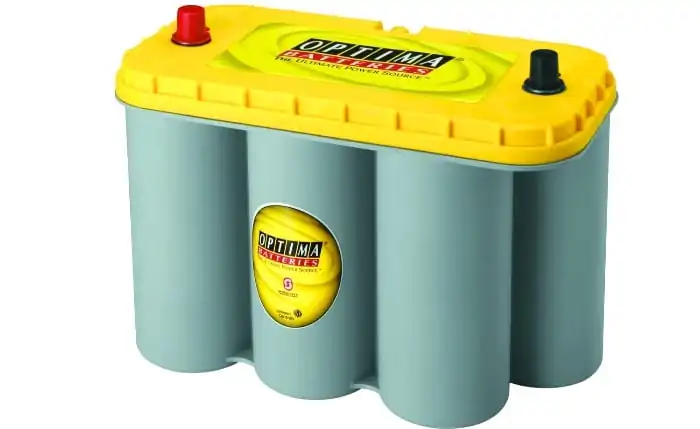
Do I need to remove the battery in winter
All drivers are divided into two camps. Some believe that the battery is sensitive to low temperatures, and therefore, to quickly start the engine, they remove the battery at night. The second ones are sure that such a procedure can harm the electronics of the machine (knock down the settings).
Modern batteries are resistant to frost, so new batteries that have not exhausted their life do not need to be stored in a warm room. The electrolyte in them is of sufficient density to prevent crystallization of water.
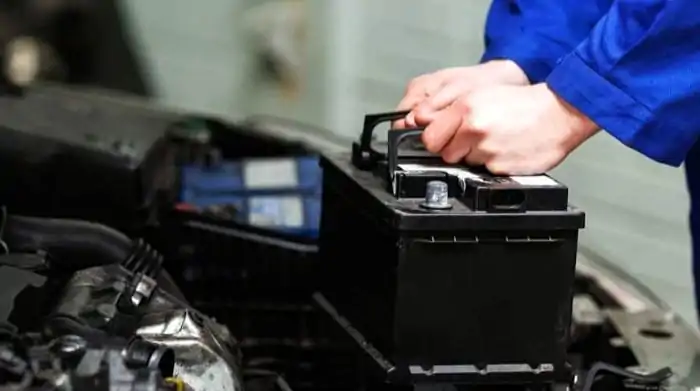
In the case of old models, which have almost exhausted their resources, such a procedure will slightly extend the “life” of the battery. In frost, in an electrolyte that has lost its density, water can crystallize, so they are not left for long in the frost. However, such a procedure is only a temporary measure before buying a new battery (for how to check the battery, read here) The old power supply dies to the same extent, both in the cold and in the heat.
In case of prolonged downtime of the vehicle, it is recommended to disconnect the battery. There are two reasons for this. Firstly, even with the devices turned off, the electric circuit is powered, and microcurrents move along it. Secondly, an unattended connected powerful battery is a potential source of ignition.
Preparing the battery for winter
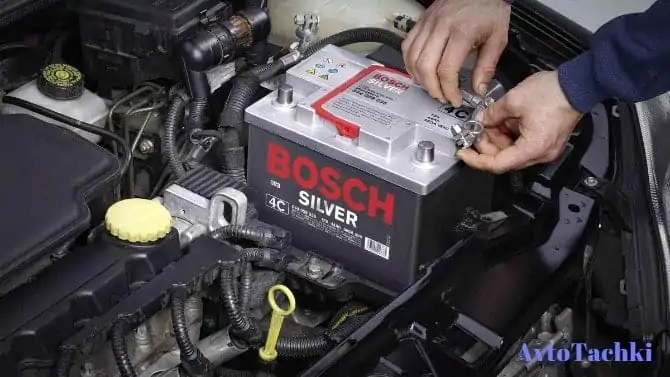 Long winter downtime causes the battery to drain quickly. This is a fact, and there’s no way to leave it, but it’s quite possible to reduce the damage done to electrical elements. To do this, simply remove one terminal from your battery. This will not affect the condition of the car, at least for the worse, but you will save many elements from the need to work in the cold. We advise you to disconnect the negative first, and only then the positive contact. This will prevent a short circuit.
Long winter downtime causes the battery to drain quickly. This is a fact, and there’s no way to leave it, but it’s quite possible to reduce the damage done to electrical elements. To do this, simply remove one terminal from your battery. This will not affect the condition of the car, at least for the worse, but you will save many elements from the need to work in the cold. We advise you to disconnect the negative first, and only then the positive contact. This will prevent a short circuit.
Dry (dry-charged) battery
First of all, the battery should be removed and cleaned of dirt. The next step is to unscrew the plugs and check the electrolyte level. Ideally, it should be 12-13 millimeters. This is enough to cover the plates in the jars. If there is not enough fluid, add distilled water to the battery. Do the filling gradually, in small doses, so as not to "overdo it."
Next, you need to check the density of the electrolyte. To do this, use a special device called a hydrometer. Collect electrolyte into the flask and achieve such a state of the float so that it does not touch the walls and bottom. Next, look at the marks of the device, which will demonstrate density. The normal rate varies between 1.25-1.29 g / m³. If the density is lower, acid should be added, and if more, distillate again. Note that this measurement should be done at room temperature. 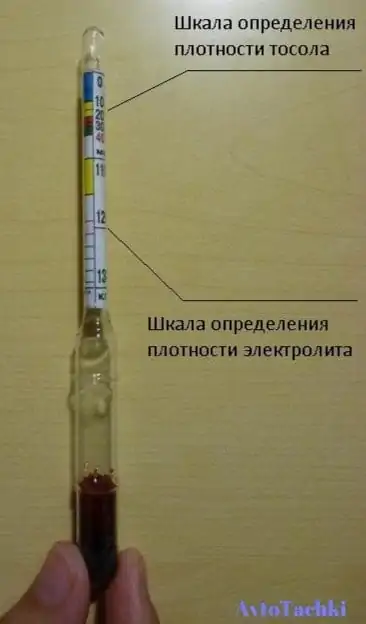
After the main work has been completed, screw the plugs into place, and carefully wipe the battery itself with a cloth moistened with soda solution. This will remove acid residues from it. Also, you can lubricate the contacts with conductive grease, it will not take much time, but it will significantly extend the battery life.
Now wrap the battery in a rag and safely send for long-term storage.
Gel battery
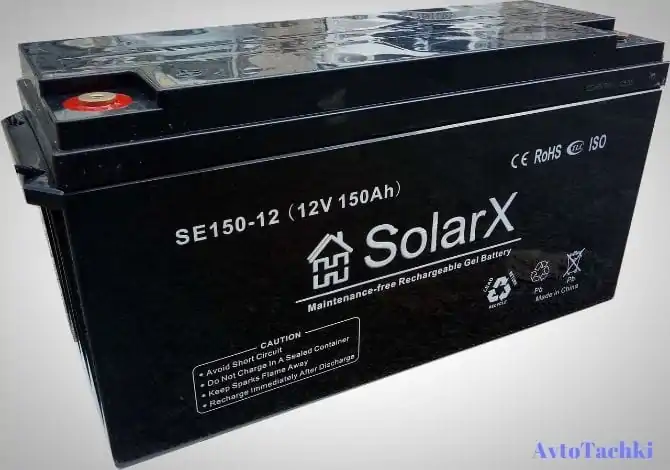 Gel batteries are among the unattended, and therefore their operation is much simpler. And they themselves are incredibly resistant to any atmospheric phenomena. Why such batteries are really whimsical is the voltage. Therefore, any manipulations with them must be done very carefully.
Gel batteries are among the unattended, and therefore their operation is much simpler. And they themselves are incredibly resistant to any atmospheric phenomena. Why such batteries are really whimsical is the voltage. Therefore, any manipulations with them must be done very carefully.
To prepare the gel battery for winter, the first thing you need to charge it. And it is advisable to do this at room temperature. Next, sequentially disconnect the terminals - minus, then plus, and send the battery for long-term storage.
Lead acid batteries (with electrolyte)
You can send such a battery for storage only in a fully charged form. Therefore, first of all, check the charge level with a multimeter. This simple and inexpensive device can be found in any electronics store.
The voltage in the battery should be 12,7 V. If you get a lower value, then the battery needs to be connected to power.
Having reached the required indicator, sequentially disconnect the terminals, and send the battery for storage, after wrapping it with an old blanket.
How and where to store the battery in winter
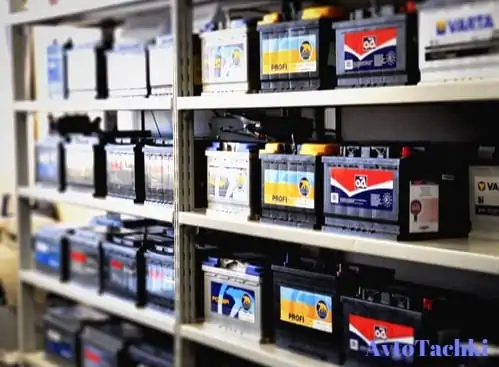 There are general rules for storing batteries, following which you will significantly extend their life. Let's consider them in more detail:
There are general rules for storing batteries, following which you will significantly extend their life. Let's consider them in more detail:
- Keeps the battery in a well-ventilated and warm room. Ideally, the air temperature should be between 5-10 degrees.
- Direct sunlight and dust can cause the battery to lose its original characteristics. Therefore, protect it by wrapping it in a thick cloth.
- It is necessary to ensure that the charge level in the battery does not fall below a critical level, because with a strong voltage drop, it stops holding the charge. It is recommended to check the battery for discharges at least once a month.
Next, we consider the features of the wound of each individual type of battery.
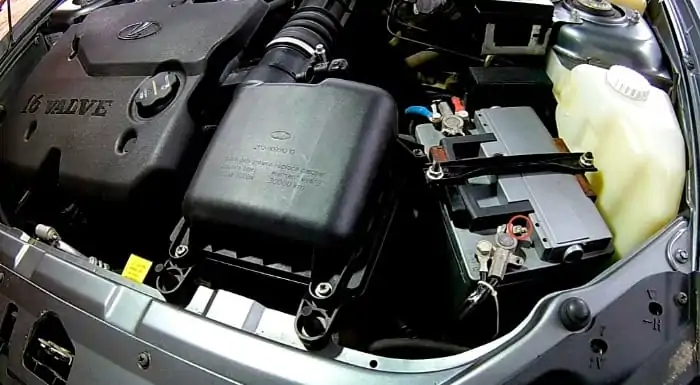
Batteries with electrolyte
In such batteries, it is worth paying special attention to plugs, as they can loosen over time, which can lead to leakage and even damage to the electrolyte. Also, try to ensure a stable room temperature so that there are no strong fluctuations, because this can cause voltage drops in the battery.
Dry-charged batteries
Such batteries can have a negative effect on the human body, therefore, their storage should be approached with extreme caution.
Please note that dry-charged batteries are only stored vertically. Otherwise, if the active electrolyte particles begin to accumulate not on the bottom, but on the walls of the cans, a short circuit may occur.
By the way, about security. Keep these batteries out of the reach of children. The bottom line is that the acid they contain is capable of harming human skin. And another important point - during the charge the battery emits explosive hydrogen. It is worth considering and recharging away from fire.
Gel batteries
Such batteries are very easy to store. They require rare recharging - at least once every six months and can withstand extreme ambient temperatures. The lower limit is at minus 35 degrees, and the upper limit is plus 65. Of course, there are almost no such fluctuations in our latitudes.
Storing a new car battery
Experts do not recommend buying a battery in advance in order to replace an obsolete one in the future. Before it hits the store counter, the battery will stand idle for a certain time at the manufacturer’s warehouse. It is difficult to track what period will pass until it falls into the hands of the buyer, so you should buy a new model as soon as this becomes necessary.
Dry-charged batteries are stored for up to three years (always in an upright position), since a chemical reaction does not occur in them. After the purchase, it is enough to pour electrolyte (not distilled water) into the banks and charge.

Refilled batteries during the storage process need periodic maintenance, so you need to check the level of electrolyte, charge and density. Long-term storage of such batteries is not recommended, because even in a calm state, they gradually lose their capacity.
Before putting the battery in storage, it needs to be fully charged, placed in a dark room with good ventilation, away from heating appliances (for how to extend the life of the battery, read another article).
Is it possible to store the battery in the cold
As already mentioned, new batteries are not afraid of frost, however, when starting a motor that has cooled down in winter, more energy is required. A frozen electrolyte loses its density and restores charge more slowly. The lower the temperature of the liquid, the faster the battery will be discharged, so it will not work for a long time to turn the starter in the cold.
If a motorist does not bring the battery overnight into a warm room, he can prevent the liquid from overcooling in banks. To do this, you can do the following:
- use a battery case at night;
- prevent cold air from entering the engine compartment (some install a cardboard partition between the radiator and grille, which can be removed during riding);
- After the trip, the motor together with the battery can be covered so that the heat is stored longer.

If the driver noticed a noticeable decrease in the operability of the power source, then this is a signal to replace it with a new one. Daily night transportation to a warm room has only a negligible effect. It is also worth considering that sudden changes in temperature (range of about 40 degrees) accelerates the destruction of cells, so the battery removed from the machine must be stored in a cool room.
In what state to store the battery
Storage and operation of the battery should be in accordance with the manufacturer's instructions. As long as the battery is new, this factor is the key, will it be covered by the warranty or not.
For the safety of the energy source, its housing must be integral, there should be no smudges and dirt on it - especially on the cover between the contacts. The battery installed in the vehicle must be firmly fixed in the seat.
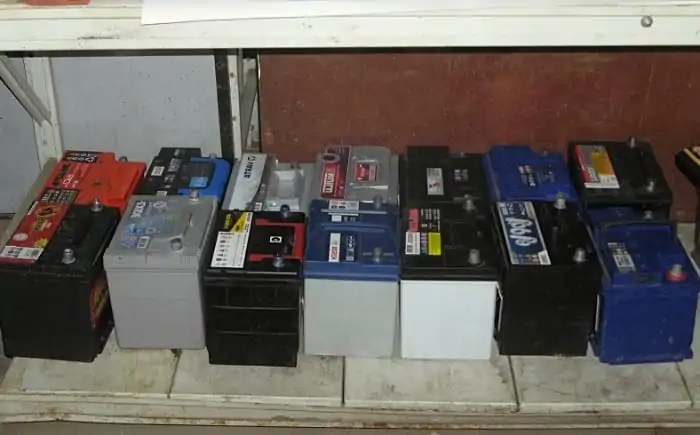
Some motorists carry a second battery in the car for reserve. This cannot be done because a charged battery should be stored in a calm state and at a relatively stable temperature. If there is a need for an additional battery, it must be connected in the same circuit with the main one.
How long can a battery be stored without recharging?
No matter how good the battery, it needs to be stored properly. Key factors to consider:
- room temperature from 0 to 15 degrees, dry place (for gel options, this range is expanded from -35 to +60 degrees);
- periodic check of open circuit voltage (with an indicator less than 12,5 V. recharging is required);
- The charge level of the new battery should not be lower than 12,6 V.
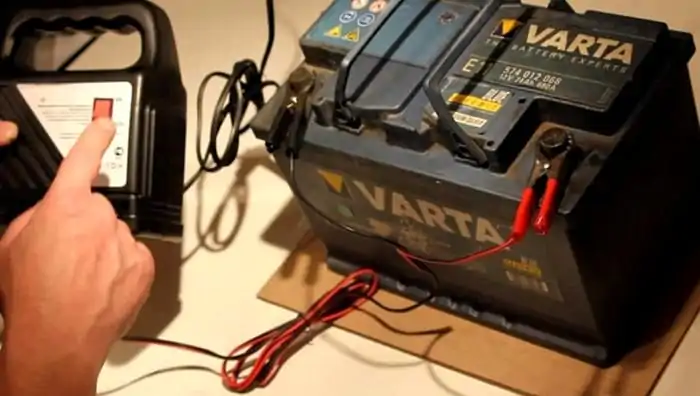
With the inaction of hybrid modifications for 14 months, the charge will decrease by 40%, and calcium will reach this indicator in 18-20 months of inactivity. Dry-charged modifications remain effective for three years. Since the battery is not the element of the car that can be stored for a long time, a lot of time should not pass between the manufacture and installation in the car.
Car battery recovery after winter
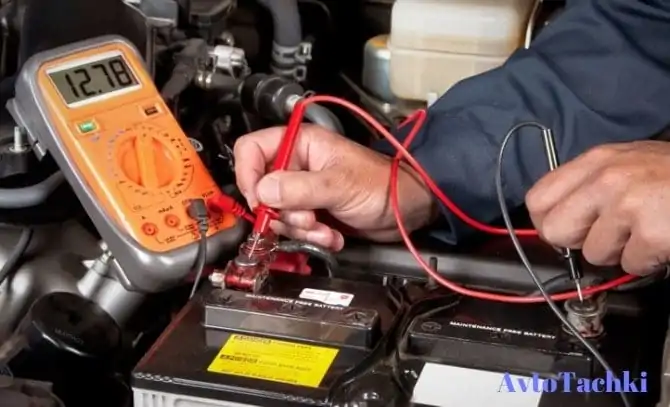
If you met all the storage conditions of the battery - periodically charged and checked the state of the electrolyte, then it can be immediately installed on the car. We preliminary recommend that you make a diagnosis again to avoid unpleasant “surprises”. For this:
- Recheck the battery level with a multimeter and, if necessary, connect it to a power source. Recall that the optimal voltage level is 12,5V and higher.
- Measure the density of the electrolyte. The norm is 1,25, but this figure should be double-checked in the battery documentation, since it can vary.
- Carefully inspect the body and, if you see electrolyte smudges, wipe it with a soda solution.
How to store the battery for a long time
If there is a need for long-term storage of the battery (the car is "canned" for wintering or long-term repairs are required), then for safety it must be properly prepared and then returned to operation correctly.
We remove the battery for storage
Conservation of the battery occurs using boric acid. It slows down the process of plate disintegration. The procedure is performed in the following sequence:
- Battery charge;
- the powder must be diluted in distilled water in a proportion of 1 tsp. per glass (you can also buy already diluted boron solution - 10%);
- using an aerometer, slowly take the electrolyte (approximately the procedure will take 20 minutes);
- to remove electrolyte residues, thoroughly rinse the cans with distilled water;
- fill the containers with boron solution and tightly close the jams on the banks;
- treat the contacts with an oxidizing agent, for example, technical petroleum jelly;
- The canned battery should be stored at a temperature of 0 to +10 degrees, out of the reach of sunlight.
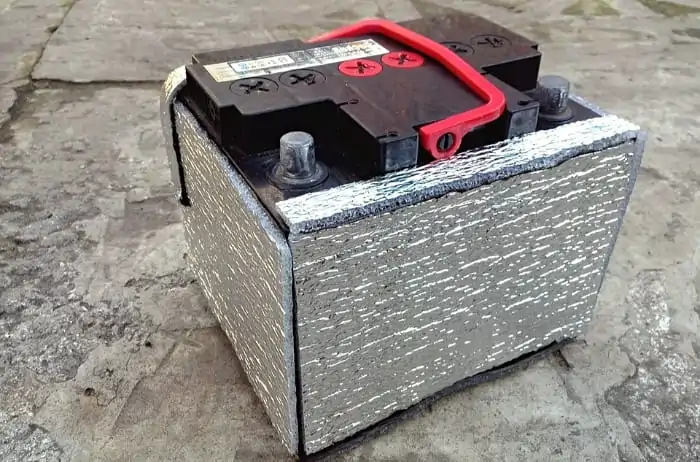
In this condition, the battery can be stored for a year or longer. It is important that the power source is in an upright position. In this case, the plates will be immersed in the solution, and will not be oxidized.
We return the performance of the preserved battery
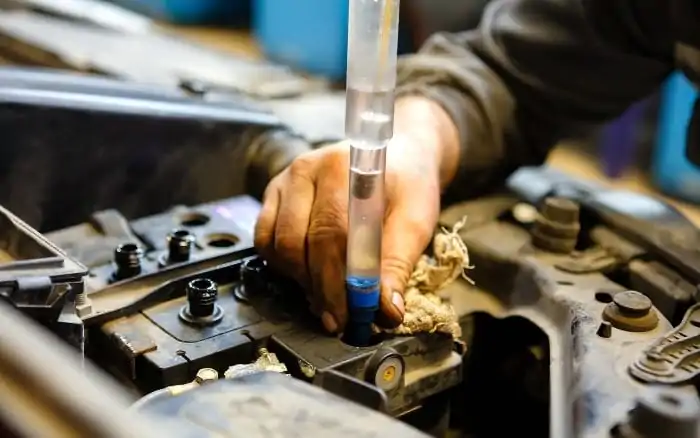
To return the battery to operation, do the following:
- slowly and accurately drain the boron solution (with an aerometer or a long syringe);
- cans should be washed (collect them with clean distilled water, leave it for 10-15 minutes. Repeat the procedure at least twice);
- dry the containers (you can use a regular or construction hairdryer);
- pour electrolyte (it will be safer to purchase it in the car shop), whose density is about 1,28 g / cm3, and wait for the reaction to start in the banks;
- Before connecting the power source to the vehicle’s electrical system, make sure that the density of the electrolyte does not drop. Otherwise, the battery needs to be charged.
In conclusion - a small reminder. Every motorist must remember: when disconnecting the battery, the negative one is removed first. terminaland then plus. The power supply is connected in the reverse order - plus, and then minus.
It's enough. Now you can install the battery in a car with confidence and turn the ignition on.
Questions and answers:
How to store a battery in an apartment? The room must be dry and cool (the temperature must be between +10 and +15 degrees). It should not be stored near batteries or other heating devices.
What's the best way to keep the battery charged or discharged? For storage, the battery must be placed in a charged state, and the charge level must be checked periodically. Voltages below 12 V can lead to sulfation of the lead plates.


One comment
Khairul anwar ali ...
Boss .. if you keep the car battery (wet) spare / second in the car can explode the battery even if it is placed in the bonnet